If an inequality contains two or more modules, it is more convenient to solve it by the method of intervals.
The process of solving inequalities with moduli using the interval method is much like the process of solving equations with moduli using the interval method.
Let's look at a few examples.
Example 1. Solve the inequality |7 - x|+|2x + 3|< 16
Solution
First, we find x such that the submodular expressions 7 - x and 2x + 3 are zero. To do this, equate these expressions to zero and solve the simplest linear equations:

Mark the numbers 7 and ![]() on the coordinate line. Mark the smaller numbers to the left, the larger to the right:
on the coordinate line. Mark the smaller numbers to the left, the larger to the right:

Now we have three intervals: ![]() ,
, ![]() , and
, and ![]() . Now we need to solve the original inequality on each of these intervals. Keep in mind that on each of these intervals the modules of the original inequality may be solved differently.
. Now we need to solve the original inequality on each of these intervals. Keep in mind that on each of these intervals the modules of the original inequality may be solved differently.
Solve the initial inequality on the first interval ![]()
Then we reason like this:
If ![]() , then for any value of x on this interval the submodular expression 7 - x becomes non-negative, and hence the module |7 - x| on the interval
, then for any value of x on this interval the submodular expression 7 - x becomes non-negative, and hence the module |7 - x| on the interval ![]() will expand with the plus sign. The second module |2x + 3| on the interval
will expand with the plus sign. The second module |2x + 3| on the interval ![]() will expand with the minus sign.
will expand with the minus sign.
Then as a result of moduli expansion on the interval ![]() the initial inequality will look like:
the initial inequality will look like:
![]()
Let's solve this inequality:

So now we consider the interval ![]() . And by solving the original inequality on this interval, we get the inequality x > -4.
. And by solving the original inequality on this interval, we get the inequality x > -4.
Now begins the most interesting part. We need to find out if the inequality x > -4 is satisfied on the interval ![]() . Or ask this question: "For what values of the interval
. Or ask this question: "For what values of the interval ![]() the inequality x > -4 is satisfied".
the inequality x > -4 is satisfied".
For clarity, let's draw another coordinate line and draw the solutions to the inequalities x > -4 and ![]() on it
on it

The figure shows at which values of interval ![]() the inequality x > -4 holds. These values are between -4 and
the inequality x > -4 holds. These values are between -4 and ![]()
So our first solution would be a range of -4 to ![]()

Now solve the initial inequality on the interval ![]()
If ![]() , then for any value of x on this interval the submodular expression 7 - x becomes non-negative, which means that the module |7 - x| on the interval
, then for any value of x on this interval the submodular expression 7 - x becomes non-negative, which means that the module |7 - x| on the interval ![]() will expand with the plus sign. The second module |2x + 3| on interval
will expand with the plus sign. The second module |2x + 3| on interval ![]() will also expand with the positive sign.
will also expand with the positive sign.
After exposing the modules on interval ![]() , the original inequality will look like this:
, the original inequality will look like this:
![]()
Solve this inequality:
![]()
Now we are looking at the interval ![]() . And by solving the original inequality on this interval we obtained the inequality x < 6. Now we need to find out if the inequality x < 6 holds at
. And by solving the original inequality on this interval we obtained the inequality x < 6. Now we need to find out if the inequality x < 6 holds at ![]()

The inequality x < 6 is not fulfilled on the whole interval ![]() , but only on the interval
, but only on the interval ![]() to 6. Write down our second solution:
to 6. Write down our second solution:

Now solve the original inequality on the last interval ![]()
If ![]() , then for any value of x on this interval the submodular expression 7 - x becomes negative, and hence the module |7 - x| on the interval
, then for any value of x on this interval the submodular expression 7 - x becomes negative, and hence the module |7 - x| on the interval ![]() will expand with a minus sign. The second module |2x + 3| at interval
will expand with a minus sign. The second module |2x + 3| at interval ![]() will expand with the positive sign.
will expand with the positive sign.
Then as a result of moduli expansion on the interval ![]() the initial inequality will look like:
the initial inequality will look like:
![]()
Solve this inequality:

Now we consider the interval ![]() . And by solving the original inequality on this interval we have obtained the inequality
. And by solving the original inequality on this interval we have obtained the inequality ![]() . Now we need to find out if the inequality
. Now we need to find out if the inequality ![]() holds at
holds at ![]()

We see that inequality ![]() is not fulfilled for any value of interval
is not fulfilled for any value of interval ![]() . This means that the original inequality on the interval
. This means that the original inequality on the interval ![]() has no solutions.
has no solutions.
Indeed, take any number from the interval ![]() , for example, the number 9, and substitute it into the original inequality. The result is an inequality that does not hold:
, for example, the number 9, and substitute it into the original inequality. The result is an inequality that does not hold:
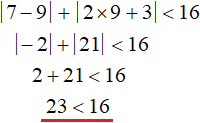
Now we need to piece together the answers we got at each interval. To do this, simply combine intervals  and
and 

Answer: (−4 ; 6).
Example 2. Solve an inequality: 3|x − 2|+|5x − 4| ≤ 10
Solution
Find x, at which the submodular expressions x - 2 and 5x - 4 are zero. To do this, equate these expressions to zero and solve the simplest linear equations:
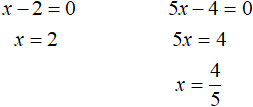
Mark the numbers 2 and ![]() on the coordinate line:
on the coordinate line:

Solve the original inequality on the interval ![]() . Both modules on this interval are expanded with minus:
. Both modules on this interval are expanded with minus:
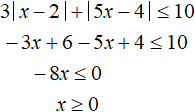
The resulting inequality x ≥ 0 is not satisfied over the entire interval ![]() , but only over the interval 0 to
, but only over the interval 0 to ![]()

Now solve the original inequality on the next interval ![]() . On this interval the module |x - 2| expands with a minus, and the module |5x - 4| with a plus:
. On this interval the module |x - 2| expands with a minus, and the module |5x - 4| with a plus:
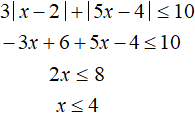
The resulting inequality x ≤ 4 holds over the whole interval ![]() . Thus on the interval
. Thus on the interval ![]() the original inequality has the following solution:
the original inequality has the following solution:

Solve the original inequality on the next interval x ≥ 2. Both modules on this interval are expanded with a plus:
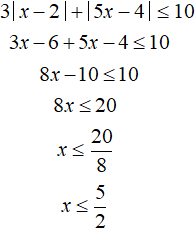
The resulting inequality ![]() is not satisfied on the entire interval x ≥ 2, but only on the interval from 2 to
is not satisfied on the entire interval x ≥ 2, but only on the interval from 2 to ![]()

Let's write down the final answer. To do this, combine the intervals  ,
,  and
and 

Answer:  .
.



 .
.

2. If you find an error or inaccuracy, please describe it.
3. Positive feedback is welcome.